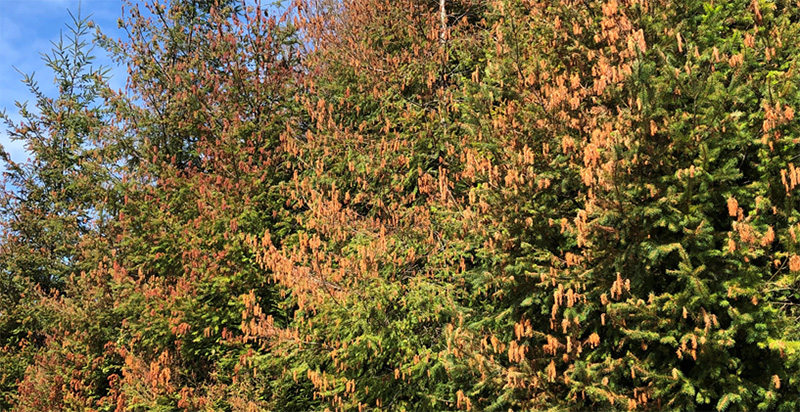Christopher Still, a professor at the Oregon State University College of Forestry, studies forest ecology and the physiology of trees. His research spans from a singular leaf on a tree to entire ecosystems. He also studies carbon cycling and forest-climate interactions.
So, when the temperatures rose to unprecedented levels in the summer of 2021 and a heat dome descended upon Oregon, Still knew the scorching heat and intense energy from the sun would stress the trees, scorch the foliage and impact Oregon’s forests. Especially after two years of state-wide drought. But at what scale? And what would that mean for the long-term health of the trees?
“The ‘heat dome’ led to numerous reports of foliage scorch and leaf drop in westside forests of the Coast Range and Cascades,” Still said. “Western hemlock and western red cedar seemed to be impacted the most, but Douglas-fir and various alders and maples were affected, too. Notably, trees and saplings with direct solar exposure and on south-facing slopes seemed to suffer the worst foliage scorch.”

With help from citizen scientists, researchers like Still spent months documenting the heat dome’s effects on Oregon’s trees. Using a website created by the Oregon Department of Forestry, community members and researchers reported their observations to map and analyze the foliage scorch.
Still then organized a symposium to share information and begin piecing together what the heat dome event might mean for the long-term health of trees.
“Researchers do not know what the near- and long-term physiological causes and consequences of foliage scorch and heat stress will be, at either leaf or tree scales. The impacts could range from impaired metabolism on surviving leaves, to reduced stem diameter growth, to eventual tree mortality,” Still says.
The symposium served as a central place for tree experts like foresters, silviculturists and botanists to meet and discuss their findings and plan for the next steps to monitor the impacts of the heat dome.
“I think there are many challenges for forest management. The challenges range from trying to help forests become more resilient to climate change impacts, to working on assisted migration and planting of new genotypes and identifying species that can better handle a warmer and drier climate in the future,” Still says.
Still says we should expect more intense heatwaves in the future, and we should all work urgently to lower our carbon footprint to mitigate future climate change.
However, he said the data shows there is much to learn about heat stress physiology and how different genotypes, species and forest types will respond to future heat and drought extremes.
“I think the scale of the impacts – both the spatial scale and the range of species and forest types affected – was surprising. I think the resilience shown by some species and forests was also a pleasant surprise,” Still says.
A version of this story appeared in the Spring 2022 issue of Focus on Forestry, the alumni magazine of the Oregon State University College of Forestry.


An arborist told us today that our cedar trees with dead tops would be dead in a year or 4 regardless of what we do. Is this true?
Hi Sheryl-You can fill out the form on this page, along with pics, for advice from an OSU Extension Agent: https://extension.oregonstate.edu/ask-expert